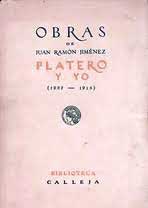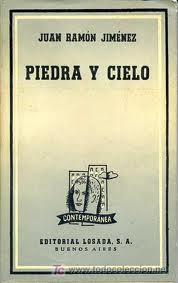Works of Juan Ramon Jimenez
Juan Ramon Jimenez wrote from quite an early age. One of his first books, "Platero y yo" (1914) is considered to be his best work. This book is read and memorized in all schools in Spain as an example of lyrical prose. Despite being so well known for this book of prose, Juan Ramon Jimenez was actually a poet most of the time, and he produced countless poetic works. Juan Ramon Jimenez was awarded the Nobel Prize of Literature in 1956, in recognition of his importance in the world of Spanish literature.
Juan Ramon Jimenez - Works
There are three periods that can be seen in the work of Juan Ramon: the sensitive period, the intellectual period, and the sufficient or true period.
The sensitive period (1898–1915)
This period can be sub-divided into two stages: The first spans until 1908; the second until 1916:
- The first is marked by Bécquer's influence: Symbolism and Modernism, assonant rhymes and intimate music. Descriptions of the landscape as a reflection of the soul of the poet are common, a landscape that's not natural but subject to the statism of an inside garden. The vague feelings, melancholy, music and drained colors, as well as memories and amorous daydreams predominate in the works of Juan Ramon. It's an emotive and sentimental type of poetry, where the sensibility of the poet is clearly visible through the perfect formal structure. The works of this stage include "Rimas" (1902), "Arias tristes" (1903), "Jardines lejanos" (1904), "Elegías" (1907).
- The second stage uses longer verses (hendecasyllabic and Alexandrine), assonant rhyme and classic stanzas (sonnets, serventesios). This stage also has a greater Modernist, Symbolist and Decadence influence. Towards the end of this period, Juan Ramon is beginning to tire of the Modernist style, especially in relation to the preoccupation with time and the possession of an eternal beauty. Works in this stage include "La Soledad Sonora" (1911), "Pastorales" (1911), "Laberinto" (1913), "Platero y yo (elegía andaluza)" (1914) and "Estío" (1916).

The most famous book of this stage, and the most famous one in all of Juan Ramon's work, is "Platero y yo", a sweet lyrical story in prose that tells the life story of a gray donkey called Platero. "Estio" signifies the change between this sensitive period and his intellectual period which follows.
The intellectual period (1916–1936)

After leaving Madrid, his first journey to America and his contact with poetry written in English (Shelley, William Blake, Yeats, Emily Dickinson) has a large impact on his second period, which Juan Ramon Jimenez himself named as his intellectual period and which is related to the Noucentisme movement. In this stage, Juan Ramon discovers the sea as a transcendental motive: sea signifies life, solitude, joy, the eternity of present time. There's also a spiritual evolution that makes the writer look for the transcendental. In his wish to fool Death, he tries to reach eternity, which he can only achieve through beauty and the depuration of his poetry. In this stage, the author eliminates all musicality, poetic arguments, ostentation and ornamentation to delve in what is pure, and beautiful and essential.
"Diario de un poeta recién casado" marked the start of this period in his writing. The poetry of this work was free of the burdens of Modernism, and was instead much more stylized and purified. Juan Ramon Jimenez also experimented in this work with different themes and forms, helping to open a new contemporary style of poetry; something which was exploited later by the members of the Generation of '27.
The most important works of this stage are "Diario de un poeta recién casado" (1916), "Primera antología poética" (1917), "Eternidades" (1918), "Piedra y cielo" (1919), "Poesía" (1917–23) and "Belleza" (1917–23).
The sufficient or true period (1937–1958)
All the works he wrote during his exile in America belong in this stage. Juan Ramon continues to write, drawn inside himself in search of beauty and perfection. His anxiety towards transcendence leads him to a certain mystique and religious stage. His poetic language turns into an idiolect with many neologisms. After a period of relative silence, he publishes "Animal de fondo" (1949), "Tercera antologia poetica" (1957), "El otro costado" (1936-1942) and "Dios deseado y deseante" (1948-1949).

